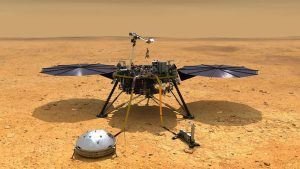Paul Voosen in Science:
 Update: NASA’s InSight spacecraft survived its descent through the thin atmosphere of Mars and successfully landed on the planet’s surface today. Although hurdles remain to achieve operating status, the lander is well positioned to begin to take Mars’s heartbeat in the next few months. “It was intense, and you could feel the emotion,” says NASA Administrator Jim Bridenstine in Washington, D.C. NASA was able to quickly confirm the landing thanks to a flawless performance by two tiny satellites that accompanied the lander. These CubeSats caught and relayed InSight’s signal to Earth, along with a bonus: a first picture of the terrain where the lander will place its two instruments. Although the picture is obscured by motes of dust on the camera, the terrain looks promising, says Rob Manning, chief engineer at the Jet Propulsion Laboratory (JPL) here. “It looks like there’s not a lot of rocks in the field of view.” A confirming “beep” of health, sent directly from InSight followed, soon after the CubeSat relay. Now, the agency must wait 5 hours for confirmation that the lander’s solar panels have been deployed. Here is our story from earlier today:
Update: NASA’s InSight spacecraft survived its descent through the thin atmosphere of Mars and successfully landed on the planet’s surface today. Although hurdles remain to achieve operating status, the lander is well positioned to begin to take Mars’s heartbeat in the next few months. “It was intense, and you could feel the emotion,” says NASA Administrator Jim Bridenstine in Washington, D.C. NASA was able to quickly confirm the landing thanks to a flawless performance by two tiny satellites that accompanied the lander. These CubeSats caught and relayed InSight’s signal to Earth, along with a bonus: a first picture of the terrain where the lander will place its two instruments. Although the picture is obscured by motes of dust on the camera, the terrain looks promising, says Rob Manning, chief engineer at the Jet Propulsion Laboratory (JPL) here. “It looks like there’s not a lot of rocks in the field of view.” A confirming “beep” of health, sent directly from InSight followed, soon after the CubeSat relay. Now, the agency must wait 5 hours for confirmation that the lander’s solar panels have been deployed. Here is our story from earlier today:
PASADENA, CALIFORNIA—A boring spot on Mars is about to get real interesting. Later today, at 11:54 a.m. PST, NASA’s $814 million InSight spacecraft will attempt to land on a flat lava plain near the martian equator. The mission will be NASA’s first landing on the Red Planet since the Curiosity rover in 2012. “I’m really confident, personally, that we’re going to land safely,” says Bruce Banerdt, the mission’s principal investigator here at JPL. “Doesn’t mean I’m not nervous.” The size of an SUV, InSight is designed to explore the martian interior by sensing “marsquakes.” It has spent the past 6 months uneventfully cruising through space, making occasional tweaks to its trajectory. That calm will break at 11:41 a.m., when the spacecraft pivots and presents its heat shield to the atmosphere. At 11:47 a.m., the spacecraft will begin its screaming plunge toward the surface; friction will send temperatures on the heat shield soaring to 1500°C.
More here.
